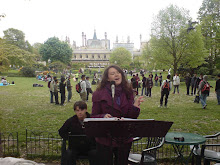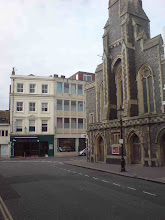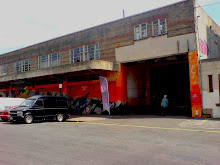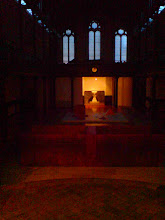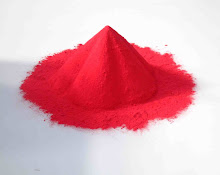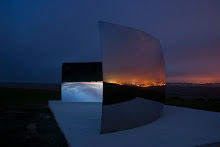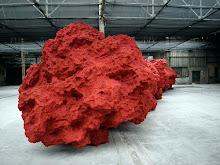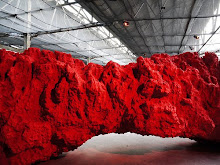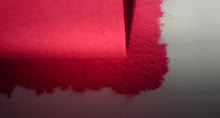SKY MIRROR
In the wonderful Pavilion Gardens, slightly to one side of the Royal Pavilion, Sky Mirror is one of the Anish Kapoor trade mark works. There are versions in New York and Nottingham. This one’s a bit smaller than either of those, but with all the fabulous architecture and lush nature acting as a framing device this piece is a good place to start a tour around all of the work. Gets you off to a good feel. To linger longer, the café in the gardens, if it’s open (9am-4pm approx, not open in wet weather) is pretty good too, the cakes are worth the effort.
Pavilion Gardens, New Rd, Brighton BN1 1HJ FREE. open 24hrs a day.
THE DISMEMBERMENT OF JEANNE D'ARC
A new sculpture, or rather a series of sculptures made specifically for this great location, the disused municipal fruit and veg wholesale market. Five huge abstracted body parts are laid out, post mortem style. All of them rich, morbid, deep signature red. Anish is quoted as saying this is a new departure for him, but it could be seen as a continuation. The usual techniques and materials are there, pigment, deceptive hole, huge maroon things. It’s just a bit more grizzly than his usual sublime. Feels like Mr Kapoor letting the dogs out.
The Old Market. Circus St, Brighton BN2 9QF behind Brighton University gallery on Grand Parade. FREE. Open 12-8pm
IMAGINED MONOCHROME
Now this really is a whole new ball game. The complete personalised AK experience, an all over sensory Kapoor. No physical manifestation, a reading and then a massage. Imagined and suggested colour, it’s all in your head. Are these the first steps to a new Anish Kapoor methodology or is it a continuation of his involvement with dance and opera? No hard and fast rules or critique. Entrance is every half an hour. Booking beforehand is essential as there are no tickets on the door. Go there with a sandwich, stimulants and your own texts as there are sure to be queues.
The Basement, Kensington Street, Brighton BN1 4AJ Everyday during the festival 10am-6pm. Tickets £12 only from the Festival Box Office 01273-709709
The Basement is in the old Argus print works in the North Laines, amidst all the little shops. Look out for the graffiti on the walls across the street from the Basement.
BLOOD RELATIONS
Wander over, back towards the sea, past the Sky Mirror again, to Fabrica in Ship St. In this disused church turned gallery there are two earlier works by Anish Kapoor. The big metal blood bath and raised text that is his collaboration with Salman Rushdie that is the aforementioned Blood Relations (2006). And the rather more delicate work, 1000 names, (1979) which uses colourful pigments. Also in Fabrica is a collection of informative writings about all of Kapoor’s work and a crew of wised up gallery assistants, should you need help or reorientating.
Fabrica, 40 Duke Street, Brighton BN1 1AG 01273-778646 www.fabrica.org.uk
On the corner of Ship St and Duke St, just off North Rd, across the road from Browns café. Opening times 12-8pm everyday during the festival. FREE.
C-CURVE
For this sculpture you’ll need to get a bus or drive, as it’s out of town. The spectacular walk is worth making the effort for in itself, particularly if it’s a bright sunny May day. The C-Curve is a different style of shiny reflective object, placed on the crest of one of the rolling hills above Brighton. For added resonance, Mr Kapoor’s sculpture has been located just above the Chattri, a bleached white shrine created to be a memorial to all the Indian soldiers who fought in the 1st world war. It really is an enchanting place of calm, repose, and picnics.
The Chattri. FREE, 24hr access.
An easy 30 minute signed walk from the Patcham roundabout at the junction of the A23 and A27. Follow the directions to Lewes until the second roundabout. There is a minor road off this roundabout, look for signs for the RSPCA or Braypool Lane. Park just after the turning, the downland path for the Chattri starts here.
Bus 5A from North St or the Old Steine, £1.80 single, £3.40 day return. Get off in Patcham, in the centre of the village walk up Church Hill until Vale Ave, follow the footpath alongside the motorway slip road. When you have crossed the bridge over the flyover to the smaller roundabout, the footpath across the downs to the Chattri is signposted from there. The Chattri website has a small map. www.chattri.com


























